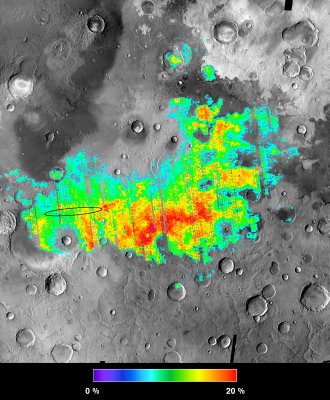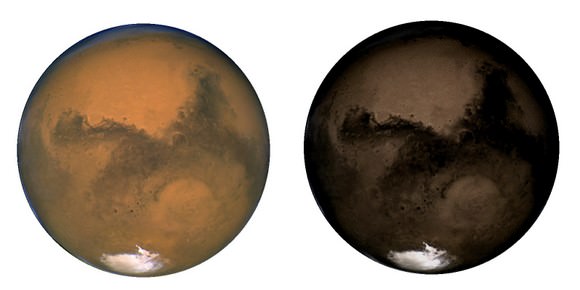[/caption]
Is Mars red due to rocks being rusted by the water that once flooded the red planet? And is the only explanation for the hematite found by Mars orbiters and studied by the Mars Exploration rovers is that water once was present in volumes on Mars? Not necessarily, says a new study. Research done by Dr. Jonathan Merrison at the Aarhus Mars Simulation Laboratory in Denmark shows that the red dust that covers Mars may be formed by ongoing grinding of surface rocks. Liquid water need not have played any significant role in the red dust formation process.
“Mars should really look black, between its white polar caps, because most of the rocks at mid-latitudes are basalt,” said Merrison. “For decades we assumed that the reddish regions on Mars are related to the water-rich early history of the planet and that, at least in some areas, water-bearing heavily oxidized iron minerals are present.”
Fine red dust covers Mars’s surface and is even present in Mars’s atmosphere, dominating the weather and sometimes becoming so thick that it plunges the planet into darkness. Even though dust is ubiquitous, we do not fully understand its physical, chemical and geological properties.
Merrison and his team have been working on getting accurate measurements of the composition and mineralogy of Mars in order to understand the structure and evolution of the near-surface environment and its interaction with the atmosphere, as well as in searching for potential habitats on Mars.
In their recent laboratory study, the scientists at the Mars Simulation Laboratory have pioneered a novel technique to simulate the sand transport on Mars. They hermetically sealed sand (quartz) t samples in glass flasks and mechanically “tumbled” them for several months, turning each flask ten million times. After gently tumbling pure quartz sand for seven months, almost 10% of the sand had been reduced to dust. When scientists added powdered magnetite, an iron oxide present in Martian basalt, to the flasks they were surprised to see it getting redder as the flasks were tumbled.

“Reddish-orange material deposits, which resemble mineral mantles known as desert varnish, started appearing on the tumbled flasks. Subsequent analysis of the flask material and dust has shown that the magnetite was transformed into the red mineral hematite, through a completely mechanical process without the presence of water at any stage of this process,” said Dr. Merrison.
The scientists suspect that, as the quartz sand grains are tumbled around they get quickly eroded and an alteration of minerals through contact ensues. How exactly this happens need to be further investigated through more experimental and analytical work. What is clear though is that the first experiments show that this process occurs not only in air but also in a dried carbon dioxide atmosphere, that is, in conditions that perfectly resemble those occurring on Mars. It may also imply that the reddish Martian dust is geologically recent.
Scientists worldwide, aided by new missions and improved instrumentation reaching the planet, will continue developing new improved computer models and Earth-bound simulators to try to pierce through the red planet’s mysteries.
“By simulating the conditions and developing accurate analogues of the Martian environment, we will certainly gain a deeper understanding of its dusty nature. In particular, developing better analogues of the Martian surface and atmosphere is vital in interpreting observations made on Mars by landers as well as pioneering the next generation of experiments to be flown,” said Dr Merrison.
Merrison presented his findings at the European Planetary Science Congress last week.
Source: Europlanet


Well, that simplifies the red/dust observations. So 2xFe3O4 + CO2 -> 3xFe2O3 + C ?
Making it even more of a mystery where the carbon went, I suppose.
To T. Larsson-
What do you mean by “where the carbon went”? Do you mean atmospheric carbon?
Magnetite Fe_3O_4 is one part wüstite (FeO) and one part hematite Fe_2O_3. The chemical process probably involves silicon in the quartz, so the carbon gets taken up into silicon carbide. So the quartz grains might have surfaces with SiC.
LC